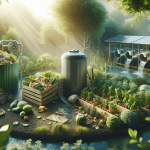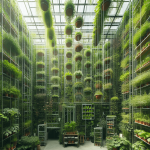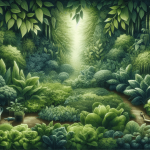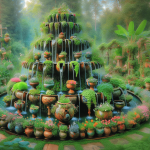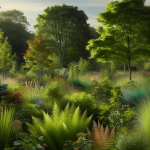This post may contain affiliate links. As an Amazon Associate, we may earn commissions from qualifying purchases.
Creating a wildlife-friendly garden is easier than you think. By incorporating a few simple adjustments and embracing nature, you can transform your backyard into a thriving habitat for various animals. From colorful birds to buzzing bees, this article will guide you on how to design and maintain a garden that not only looks beautiful but also supports the vibrant ecosystem around you. So, grab your gardening gloves, and let’s embark on this exciting journey to create an inviting space where wildlife can flourish.
Provide Food Sources
Plant native plants
One of the best ways to create a wildlife-friendly garden is by planting native plants. Native plants are well adapted to the local climate and provide food sources for a wide variety of animals. They attract native insects, birds, and other wildlife that rely on them for survival. By planting native plants, you can help support the local ecosystem and provide a sustainable food source for wildlife in your garden.
Include a variety of plants
In addition to planting native plants, it’s important to include a variety of plants in your garden. Different species of plants produce different types of flowers, fruits, and seeds, which attract a wider range of wildlife. By planting a diverse selection of plants, you can create a more balanced and resilient ecosystem in your garden. Consider including trees, shrubs, wildflowers, and grasses to provide a diverse habitat for wildlife.
Leave seed heads and berries
Another way to provide food sources for wildlife is by leaving seed heads and berries intact. Many plants produce seeds and berries that are valuable food sources for birds, squirrels, and other animals. Instead of removing them, allow the seed heads to mature and the berries to ripen. This will not only provide food for wildlife but also add visual interest to your garden during the winter months.
Provide feeders
If you want to attract specific types of birds or other wildlife, consider providing feeders in your garden. Bird feeders can be filled with seeds, nuts, or suet, depending on the species you want to attract. Squirrel feeders can also be added to divert their attention from other areas of your garden. However, it’s important to clean the feeders regularly to prevent the spread of diseases among the wildlife.
Create Water Features
Install a birdbath or pond
Water is essential for wildlife, and installing a birdbath or pond in your garden can help provide a reliable water source. A shallow birdbath or a small pond with gently sloping edges is ideal for attracting birds and other small animals. Ensure that the water feature is easily accessible and kept clean to prevent the spread of diseases. For a birdbath, consider placing it in a shaded area to keep the water cool during hot summer days.
Keep water clean and fresh
Maintaining clean and fresh water is crucial for the health of wildlife that relies on it. Birds, in particular, may avoid dirty or stagnant water sources. To keep the water clean, change it frequently, especially during hot weather when bacteria can multiply quickly. Scrub the birdbath or pond regularly to remove any algae or debris. This will not only attract wildlife to your garden but also contribute to their well-being.
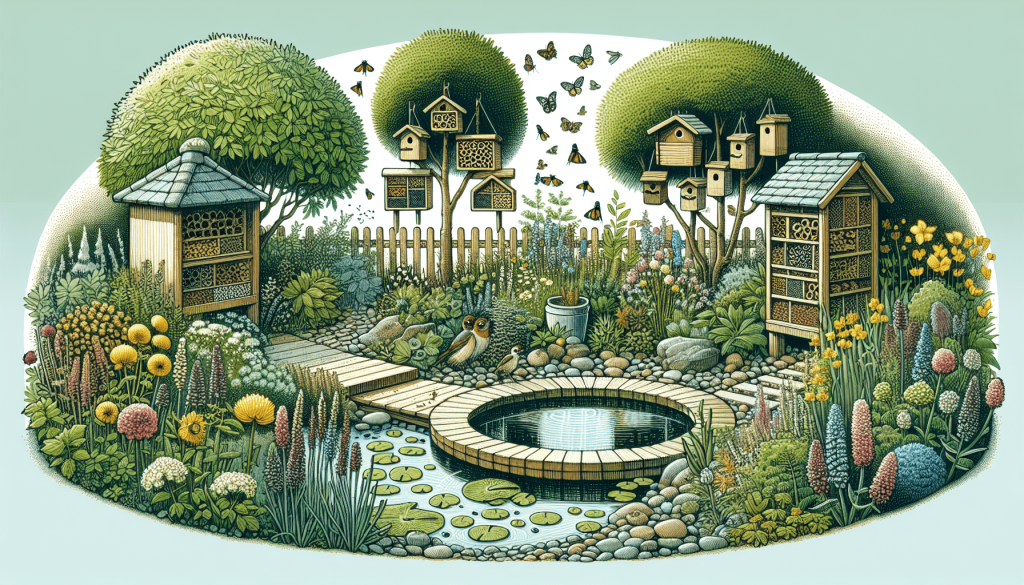
Provide Shelter
Plant dense shrubs and bushes
Shelter is an essential component of a wildlife-friendly garden. Dense shrubs and bushes provide hiding places, nesting sites, and protection from predators. Planting evergreen shrubs can also offer year-round cover for wildlife. Consider using a mix of shrubs and bushes of varying heights to create layers of sheltered areas. This will attract different types of birds, small mammals, and insects seeking protection in your garden.
Create nesting boxes
Nesting boxes are a great way to provide additional shelter for birds. They offer a safe place for nesting and raising young, particularly for cavity-nesting species like bluebirds, chickadees, and wrens. Ensure that the nesting boxes are correctly designed and correctly placed to maximize their use. Different species have different preferences for entrance hole size and box height. Research the requirements of the birds in your area to create suitable nesting opportunities.
Leave a brush pile
A brush pile can serve as a natural shelter for various wildlife, including mammals, reptiles, and amphibians. By stacking fallen branches, logs, and leaves in a designated area of your garden, you create a safe space for animals to find shelter, hide from predators, and even hibernate during the colder months. A brush pile can also attract insects, which in turn provide a valuable food source for birds and other animals.
Provide deadwood
Deadwood, such as standing or fallen tree trunks, is an important habitat for a variety of wildlife. It offers nesting opportunities for birds, hiding places for mammals, and a habitat for insects and fungi. If you have deadwood in your garden, consider leaving it in place rather than removing it. However, it’s essential to ensure that the deadwood is stable and does not pose a safety risk.
Avoid Chemicals
Use organic or natural pest control methods
When creating a wildlife-friendly garden, it’s essential to avoid using chemical pesticides and herbicides. These can be harmful to insects, birds, and other animals that rely on them as a food source. Instead, opt for organic or natural pest control methods, such as attracting beneficial insects, using companion planting, or manually removing pests. This way, you can maintain a healthy ecosystem while minimizing the negative impact on wildlife.
Avoid chemical fertilizers and pesticides
Chemical fertilizers and pesticides can have detrimental effects on wildlife and the environment. Instead of using these products, consider using organic fertilizers, compost, or natural alternatives. Organic fertilizers provide nutrients to the soil without harmful chemicals, and compost can improve soil health and fertility. By avoiding chemical fertilizers and pesticides, you not only protect wildlife but also create a safer and more sustainable garden environment.
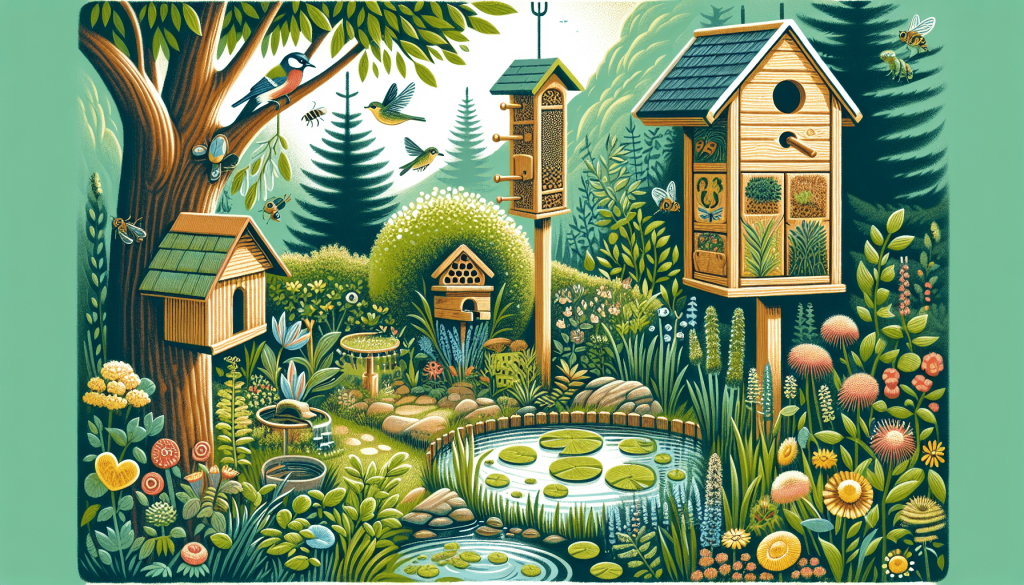
Create a Pollinator-friendly Space
Plant flowers that attract pollinators
Pollinators such as bees, butterflies, and hummingbirds play a crucial role in the reproduction of many plants. To create a pollinator-friendly garden, incorporate flowers that attract these essential insects and birds. Choose a variety of flowers with different shapes, colors, and bloom times to provide nectar throughout the growing season. Native wildflowers like coneflowers, bee balm, and milkweed are particularly attractive to pollinators.
Provide a water source for pollinators
Pollinators also require access to water, so providing a water source in your garden is vital. A shallow dish filled with water or a small, shallow pond can serve as a water station for bees and butterflies. Adding a few stones or floating vegetation in the water can help them easily drink without the risk of drowning. Placing the water source near the flowers will attract pollinators to both nectar and water.
Avoid using insecticides on pollinator plants
To maintain a pollinator-friendly space, it’s crucial to avoid using insecticides on the plants that attract pollinators. Even organic insecticides can harm beneficial insects like bees and butterflies. Instead of resorting to chemical sprays, consider natural pest control techniques, like introducing beneficial insects or using physical barriers, to manage any potential pests. This way, you can support pollinators and the plants that depend on them for reproduction.
Offer Nesting Opportunities
Leave dead trees or snags
Dead trees or snags can provide valuable nesting opportunities for birds and other wildlife. Many cavity-nesting birds, such as woodpeckers, owls, and bluebirds, rely on dead trees for nesting sites. If you have a dead tree in your garden that does not pose a safety risk, consider leaving it as a natural nesting habitat. Over time, the wood will begin to decompose, attracting insects and providing a source of food for wildlife.
Create a nesting area for ground-dwelling birds
Some birds, like sparrows or towhees, prefer to nest on the ground rather than in trees or shrubs. To accommodate ground-dwelling birds, leave an area of your garden with tall grass or low vegetation. This will provide them with a safe and secluded place to build their nests and raise their young. Ensure that the area remains undisturbed during the breeding season to allow the birds to nest in peace.
Minimize Artificial Lights
Reduce outdoor lighting
Artificial lights can disrupt the behavior and migration patterns of birds and nocturnal animals. To create a more wildlife-friendly environment, reduce outdoor lighting in your garden. Install motion-sensing lights or use low-intensity, downward-facing fixtures to minimize light pollution. This will not only benefit wildlife but also create a more tranquil and peaceful atmosphere in your garden.
Use motion-sensing lights
If you require lighting in your garden for safety reasons, consider using motion-sensing lights. These lights only turn on when they detect movement, minimizing the overall impact on wildlife. Additionally, motion-sensing lights can help deter nocturnal animal pests, such as raccoons or deer, from your garden. By using this type of lighting, you strike a balance between the needs of wildlife and your own garden maintenance requirements.
Shade windows to prevent bird collisions
Large windows can pose a significant risk to birds, as they may not perceive the glass and can collide with it, often with fatal consequences. To prevent bird collisions, shade your windows using curtains, blinds, or window film. Alternatively, you can apply window decals or create a pattern on the glass to make it more visible to birds. By taking these preventive measures, you can help protect birds and reduce unnecessary injuries or fatalities.
Maintain a Wildlife-friendly Lawn
Reduce mowing frequency
Mowing your lawn less frequently can benefit wildlife in several ways. Longer grass provides shelter and hiding places for small animals like insects, frogs, and snakes. It also allows wildflowers and native grasses to grow, which provide food sources for pollinators and other wildlife. Consider mowing your lawn only when necessary and letting specific areas grow longer to create habitats and food sources for different species.
Leave patches of longer grass
In addition to reducing mowing frequency, leaving patches of longer grass or creating wildflower meadows can enhance the biodiversity of your garden. These areas attract a variety of insects, birds, and small animals that thrive in natural habitats. By incorporating these patches into your lawn, you create microhabitats that provide food, shelter, and breeding grounds for a diverse range of wildlife.
Avoid using herbicides
Herbicides can be harmful to wildlife, especially insects and other small animals that rely on plants for survival. Avoid using herbicides in your garden, as they can negatively impact the ecosystem and disrupt the food chain. Instead, consider using manual methods, such as pulling weeds or using natural weed control techniques, to manage unwanted plants. This way, you can maintain a healthy, wildlife-friendly lawn without compromising the well-being of the ecosystem.
Provide Habitat for Wildlife
Create wild areas with native vegetation
To create a wildlife-friendly garden, designate areas of your garden as naturalized or wild areas. These areas should be left undisturbed, allowing native vegetation to grow freely. Native plants, including grasses, wildflowers, and shrubs, provide crucial habitat for wildlife, attracting insects, birds, and small mammals. By creating wild areas, you contribute to the preservation of local biodiversity and provide additional habitats for a range of wildlife species.
Add features like rocks and logs
Incorporating natural features like rocks and logs into your garden can enhance the habitat for wildlife. Rocks provide basking spots for reptiles, hiding places for small mammals, and perches for birds. Fallen logs offer shelter and food sources for insects and fungi, which, in turn, attract a diverse range of wildlife. By strategically placing these features throughout your garden, you create natural habitats that mimic the variety found in the wild.
Leave an undisturbed corner of the garden
Even in the most meticulously designed gardens, it’s essential to leave a corner or area undisturbed to provide a sanctuary for wildlife. This undisturbed space will allow plants, insects, birds, and other animals to thrive without human interference. Avoid pruning, weeding, or tidying this area, as it is meant to provide a natural and untouched environment. By incorporating this element into your garden, you maximize the potential habitat for a range of wildlife species.
Regular Maintenance and Monitoring
Prune plants carefully
When maintaining your wildlife-friendly garden, take care when pruning plants. Avoid pruning during nesting season to prevent disturbing nesting birds or inadvertently removing their nests. Additionally, consider leaving some dead branches or leaving shrubs untrimmed, as they can provide valuable shelter and food sources for wildlife. By being mindful of the timing and extent of your pruning, you can minimize disruption to the wildlife in your garden.
Monitor for pests and diseases
Regularly monitor your garden for signs of pests and diseases. By catching these issues early, you can address them without resorting to chemical pesticides or herbicides. Sudden changes in plant health, unusual insect activity, or signs of disease should be promptly investigated. Research organic and natural methods for pest control to manage any problems sustainably. This way, you maintain a healthy ecosystem while minimizing potential harm to wildlife.
Clean bird feeders regularly
If you provide bird feeders in your garden, it’s essential to clean them regularly. Bird feeders can become contaminated with bird droppings, mold, or bacteria, which can be harmful to birds’ health. Clean the feeders with hot, soapy water and rinse them thoroughly. It’s also a good idea to periodically rotate or move feeders to prevent the buildup of waste material under the feeders. By maintaining clean feeders, you ensure that the food provided is safe for the birds and prevent the spread of diseases.
Creating a wildlife-friendly garden is a rewarding endeavor that benefits both the environment and the various species of wildlife that depend on it. By following the tips outlined above, you can create a diverse and thriving ecosystem that supports native plants, insects, birds, and other animals. Whether you have a small urban garden or a sprawling backyard, every effort counts in creating a habitat that provides food, shelter, and safety for wildlife. So get started today and enjoy the beauty and wonder of a wildlife-friendly garden right in your backyard.


